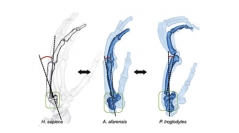

 Comptes Rendus Palevol
16 (5-6) - Pages 572-584
Comptes Rendus Palevol
16 (5-6) - Pages 572-584While no consensus allows explaining how and when human-like traits arose in fossil hominin hands, the recent discoveries of the Lomekwian stone tools (3.3 Ma) support the view that early hominins were able to use forceful grips in order to manipulate large-sized blocks for pounding activities. Then, assessing gripping abilities of contemporaneous hominin, i.e. Australopithecus afarensis , is necessary, particularly with regards to its unusual 5th ray morphology that has been deemed crucial to ensure forceful grips. Here, we present a musculoskeletal simulation based on the A. afarensis hand morphology that includes an original 5th carpometacarpal joint. Our first results suggest a limited influence of muscle parameters (e.g., PCSA) and support the value of simulations for studying extinct taxa even in absence of soft-tissue data. Given the inability for the pulp of the 5th ray to face the surface of a large-sized object, the A. afarensis hand would have had limited possibility to exert sufficient force to make the Lomekwian stone tools.
Tool making, Forceful hand grips, Pliocene, Fifth ray, Musculoskeletal modelling, Inverse dynamics